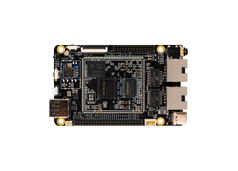2. CAN¶
2.1. Introduction¶
Controller area network (can) is a kind of serial communication network which can effectively support distributed control or real-time control. Can bus is a bus protocol widely used in automobile, which is designed as the communication of microcontroller in automobile environment.
2.2. Hardware Connection¶
Note: The CAN pins on the pin header only lead out the CAN TX and CAN RX interfaces. There is no built-in CAN transceiver IC on the board. Therefore, there is no way to test the CAN interface directly. You need to connect a CAN transceiver module to perform CAN transceiver testing. And the default CAN configuration is closed. If you need to use and test, please open the CAN0 and CAN1 configurations in the corresponding dts files.
Open CAN0 and CAN1 configuration
#define CAN0 1
#define CAN1 1
By using the RM_IO feature, the GPIOs of CAN TX and CAN RX are flexibly set to the following pins:
CAN0
GPIO0_B6 –> can0_tx ; GPIO0_C0 –> can0_rx
CAN1
GPIO0_C1 –> can1_tx ; GPIO0_C3 –> can1_rx

2.3. DTS Configuration¶
Common
kernel/arch/arm/boot/dts/rk3506.dtsi
can0: can@ff320000 {
compatible = "rockchip,rk3506-canfd", "rockchip,rk3576-canfd";
reg = <0xff320000 0x1000>;
interrupts = <GIC_SPI 45 IRQ_TYPE_LEVEL_HIGH>;
clocks = <&cru CLK_CAN0>, <&cru HCLK_CAN0>;
clock-names = "baudclk", "apb_pclk";
resets = <&cru SRST_CAN0>, <&cru SRST_H_CAN0>;
reset-names = "can", "can-apb";
assigned-clocks = <&cru CLK_CAN0>;
assigned-clock-rates = <300000000>;
status = "disabled";
};
can1: can@ff330000 {
compatible = "rockchip,rk3506-canfd", "rockchip,rk3576-canfd";
reg = <0xff330000 0x1000>;
interrupts = <GIC_SPI 46 IRQ_TYPE_LEVEL_HIGH>;
clocks = <&cru CLK_CAN1>, <&cru HCLK_CAN1>;
clock-names = "baudclk", "apb_pclk";
resets = <&cru SRST_CAN1>, <&cru SRST_H_CAN1>;
reset-names = "can", "can-apb";
assigned-clocks = <&cru CLK_CAN1>;
assigned-clock-rates = <300000000>;
status = "disabled";
};
Board configuration
kernel/arch/arm/boot/dts/rk3506b-firefly-roc-rk3506b-cc.dtsi
&can0 {
status = "okay";
pinctrl-names = "default";
pinctrl-0 = <&rm_io14_can0_tx &rm_io16_can0_rx>; //GPIO0_B6 --> can0_tx ; GPIO0_C0 --> can0_rx
};
&can1 {
status = "okay";
pinctrl-names = "default";
pinctrl-0 = <&rm_io17_can1_tx &rm_io19_can1_rx>; //GPIO0_C1 --> can1_tx; GPIO0_C3 --> can1_rx
};
assigned-clock-rates can modify. If it is less than or equal to 3Mbps, it is recommended to modify the can clock to 100M, so that the signal is more stable. If it is higher than 3Mbps, the clock can be set to 200M.
2.4. Communication¶
2.4.1. CAN communication test¶
Use the candump and cansend tools directly to send and receive messages, Ubuntu can use “apt update && apt install can-utils” to install them.
Tools candump/cansend are included with the SDK and download from Officail link or github.
#Close the can0 device at the transceiver
ip link set can0 down
#Set the bit rate to 250Kbps at the transceiver
ip link set can0 type can bitrate 250000 dbitrate 1000000 fd on
#Show can0 details
ip -details link show can0
#Open the can0 device at the transceiver
ip link set can0 up
#Perform candump on the receiving end, blocking waiting for messages
candump can0
#Execute cansend at the sending end to send the message
cansend can0 123#1122334455667788
2.5. More Command¶
1、 ip link set canX down //turn off CAN device
2、 ip link set canX up //turn on CAN device
3、 ip -details link show canX //show CAN device details
4、 candump canX //Receive data from CAN bus
5、 ifconfig canX down //shutdown CAn device
6、 ip link set canX up type can bitrate 250000 //Set CAN Baudrate
7、 conconfig canX bitrate + (Baudrate)
8、 canconfig canX start //start CAN device
9、 canconfig canX ctrlmode loopback on //loopback test
10、canconfig canX restart //restart CAN device
11、canconfig canX stop //stop CAN device
12、canecho canX //check CAN device status查看can设备总线状态;
13、cansend canX --identifier=ID+data //send data
14、candump canX --filter=ID:mask //Use the filter to receive ID matching data
2.6. FAQS¶
Summarize several problems and solutions encountered during debugging.
2.6.1. The receiving end only successfully received the message once, and then no longer received the message¶
Check if the CAN_H and CAN_L lines of the bus are loose or connected in reverse.
2.6.2. Change clock rate¶
If the bitrate of CAN is lower than or equal to 3M, it is recommended to modify the CAN clock rate to 100M to make the signal more stable. If the bitrate is higher than 3M, the clock can be set to 200M.
For example:
@@ -48,7 +48,7 @@ can0: can@ff320000 {
resets = <&cru SRST_CAN0>, <&cru SRST_H_CAN0>;
reset-names = "can", "can-apb";
assigned-clocks = <&cru CLK_CAN0>;
- assigned-clock-rates = <300000000>;
+ assigned-clock-rates = <200000000>;
status = "disabled";
};
@@ -61,7 +61,7 @@ can1: can@ff330000 {
resets = <&cru SRST_CAN1>, <&cru SRST_H_CAN1>;
reset-names = "can", "can-apb";
assigned-clocks = <&cru CLK_CAN1>;
- assigned-clock-rates = <300000000>;
+ assigned-clock-rates = <200000000>;
status = "disabled";
};
Note:
under some clock rate frequencies, the bitrate of CAN cannot obtain accurate rate. We can adjust the
assigned clock ratesto solve itCheck bitrate
ip -d link show can1
